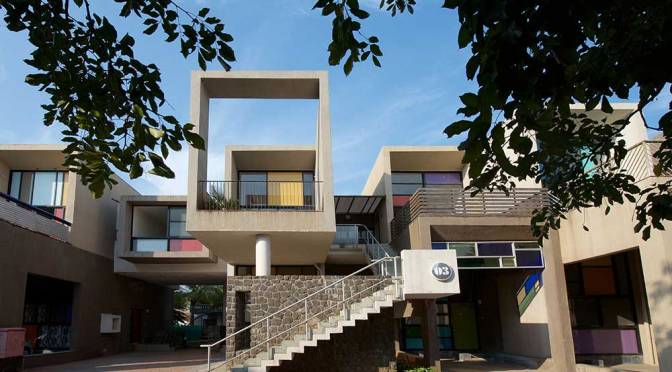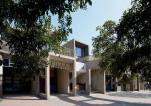The Design.I.Y HOUSING project offers a refreshing perspective to the monotony that otherwise defines contemporary commercial housing. In the context of Lonavala, this project by S+PS Architects proposes an alternative approach wherein the preferences of the inhabitants become integral to the development of architecture and essential to the richness of design.
For those who have known the housing board apartments in any city can comfortably claim how little they allow in terms of a possibility to adapt and change. Yet, if one sees the complexes by the Delhi Development Authority built about two decades back or by H.U.D.C.O in Ahmedabad, one realises that the desire to personalise space is innate to all – everything that could be changed is changed – from the grilles to the window-panes.
In housing, a space that fits all is most likely to suit none.
There have been wonderful examples in the past, built by early Indian Modernists and thought-leaders like Balkrishna Doshi, Charles Correa, Uttam Jain, Hasmukh Patel, Laurie Baker and some institutional housing projects by Anant Raje and Achyut Kanvinde that offer a certain ‘theme and variation’ pattern the inhabitants could use to manipulate space.
The very economic and institutional structures that produced that kind of housing were unique to a certain ideology that no longer holds relevance. Real-estate has become a speculative ‘demand and supply’ market and we all know intimately what we largely are offered as housing from the Developer.
Houses have become a part of a ‘production line’ that allow very little individual expression and almost no space for the identity of the inhabitants except in the interior space once the unit is handed over and lived in. The result is boring and monotonous.
The allowance and the room to make choices is crucial to housing across all levels of affordability.
Irrespective of the profile of the inhabitants and users, the desire to express and individualise space renders texture, layers and diversity to housing. Thus, the significance of the Design.I.Y Housing approach.
“People looking for a house to call home in urban areas seldom have an ability to make choices about anything – its size, layout, finishes, etc. It is mostly about how much square feet your budget can afford and then a take it or leave it situation in terms of choice. Mostly developer driven, it ends up being about efficiencies, mass production, duplication, speed, etc,” observe S+PS Architects.
The Design.I.Y Housing project in Lonavala evolves from a ‘kit of parts’ where a theme is set by the architects and the inhabitants of the house can make choices of variables within the theme. The set parameters enable the architects to maintain coherence and control over the scheme while the options enable both: the architects and the users to put together a house that accommodates an array of preferences without compromising the scheme. “We started with the idea, that what one really needs is an open adaptable space with good height, a Verandah and a patch of green with the open sky above” write the architects.
This adaptable space is designed in modules which accommodate various units from a 40 square-meter studio to a 5-bedroom villa with an area of 195 square-meters on the site. From the possibilities, one can choose the parts: windows, screens, articulation of terraces, types of internal staircases, railing designs, garden layouts and flooring-types in varying combinations to compose the whole. As described by the architects, “The particular combination that each one chooses allows one to individualise their home to reflect their own identity.” The patterns therein change the shell and adapt the unit to a particular situation in the scheme. This situation is determined by the choices made and they in-turn impact other variables.
With few and controlled devices, the architects enable the ‘system’ to navigate the design process and bring out the element of surprise.
The scheme is composed of three essential parts. The site – a 3.9 acre land with old trees and structures – is organised between a linear commercial building and a heritage club-house. The houses occupy the edges of a ‘street’ that connects the two functions. Existing structures on this old Parsi sanitarium land were adapted by the architects for recreational amenities and their presence is considered in the planning. The ‘Verandah Clubhouse’ which adapts the existing structures and changes them with contemporary interventions, additionally informs the development around the common recreation area.
“The site profile determined a street configuration in the front, entered through the gateway of the commercial building and culminated in a large open common garden court around which the remaining buildings were arranged. A green buffer zone and the clubhouse allowed the residential development to be set back a bit from the tracks. Vehicular movement is contained to a very small part of the site allowing for a variety of pedestrian networks to crisscross the site-several times terminating in small pocket play areas or a wooded park.” articulates the project description by the architects.
By organising units on the periphery, the set-back becomes a part of the private green space. The paved spine of the layout is contained in the enclosure created by the linear units on the periphery thus realising the potential of the site to the maximum. The commercial building containing shops, offices and a banquet facility secures the site and the housing behind.
The ‘system design’ involves the end-user in the architectural process, thus creating opportunities to collaborate in the evolution of the house.
Commercial housing is an omnipresent typology. The Design.I.Y Housing by S+PS Architects is an imaginative argument against the way contemporary housing schemes are designed. By generating a set of patterns and enabling choice, the architects ensure that a rich texture is created and the monotony of a repetitive unit is broken. The interior images of the housing scheme evidence the variety that is generated by the ‘kit of parts’. This strategy is essential to understand the possibilities housing can offer and the way architecture can be instrumental in creating an effervescent environment that involves the inhabitants as collaborators on the project ♦
Project Review: Ruturaj Parikh
Images & Drawings: © S+PS Architects
Photographs by: © Sebastian Zachariah, Ira Gosalia, Pinkish Shah
INFORMATION
Project Title: Design.I.Y Housing
Project Name: Shantivan
Location: Nagargaon, Lonavala
Client: Mrp Associates
Architects: S+PS Architects
Design Team: Pinkish Shah, Shilpa Gore-Shah, Divya Malu, Pooja Satam, Benny Mathew, Pratik Taishete, Divya Jain, Nusrat Karovalia, Rhea Lopes
Liaison Architects: Kanhaiya Bhurat Architects, Lonavala
Structural Engineers: Rajeev Shah & Associates, Mumbai
M.E.P Consultants: Arkk Consultants, Mumbai. R.N.Joshi
Landscape Consultants: Roots Design, Pune. Prachi & Umesh Wakaley
Project Management: Nipra Consultants, Mumbai
Chief Site Engineer: Khalil Sheikh
Initiation of Project: 2006
Completion of Project: 2016
Site Area: 15700 Square Meters [~3.88 Acres]
Project Area as per FSI: 7128 Square Meters
NOTE
‘The Verandah Clubhouse‘; a restored and refurbished part of the housing complex is intentionally excluded from the feature as the concerns and design considerations for the clubhouse demand distinct observations.



































